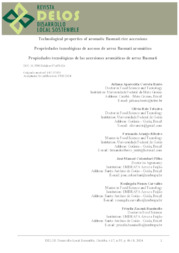Technological properties of aromatic Basmati rice accessions.
Technological properties of aromatic Basmati rice accessions.
Author(s): BENTO, J. A. C.; TEIXEIRA, O. R.; RIBEIRO, F. A.; COLOMBARI FILHO, J. M.; CARVALHO, R. N.; BASSINELLO, P. Z.
Summary: The objective of this study was to characterize the paste profile of basmati-style aromatic rice accessions. The evaluation of the 56 rice accessions by the Mean of Distances Method yielded seven groups of rice accessions based on the evaluated parameters (elongation, apparent amylose content (AAC), aroma, and paste properties). Group 1 was represented by the control sample IRGA417, a non-aromatic cultivar with the highest AAC (22.5%). The aromatic cultivars Jasmine, Empasc 104, IAC500, and Jasmine85 constituted the third group. Group 4 consisted of 41 Basmati accessions and exhibited the highest average elongation ratio (greater than 2.0). Groups 3 and 4 exhibited comparable aroma scores (2.9 and 2.8, respectively) and retrogradation processes (final viscosity: 285.37 and 291.26 RVU, and setback: 136.84 and 166.01 RVU, respectively). Group 5 was constituted with seven Basmati accessions, while groups 6 and 7 were formed with one and two Basmati accessions, respectively. Groups 5 and 6 exhibited comparable paste properties, with peak viscosities of 186.06 and 153.1 RVU, respectively, and final viscosities of 210.27 and 236.7 RVU, respectively, which were lower than those observed in the other groups. In contrast, group 7 exhibited intermediate parameters between the control IRGA417 and groups 3 and 4. Groups 3, 4, 5, 6, and 7 were classified as low amylose grains, with an AAC of 12-20%. The Basmati accession (group 4) exhibited a comparable paste profile, with a notable distinction in its high elongation, aroma, and low AAC. Consequently, these cultivars may be well accepted by consumers of aromatic rice.
Publication year: 2024
Types of publication: Journal article
Unit: Embrapa Rice & Beans
Observation
Some of Embrapa's publications are published as ePub files. To read them, use or download one of the following free software options to your computer or mobile device. Android: Google Play Books; IOS: iBooks; Windows and Linux: Calibre.
Access other publications
Access the Agricultural Research Database (BDPA) to consult Embrapa's full library collection and records.
Visit Embrapa Bookstore to purchase books and other publications sold by Embrapa.

